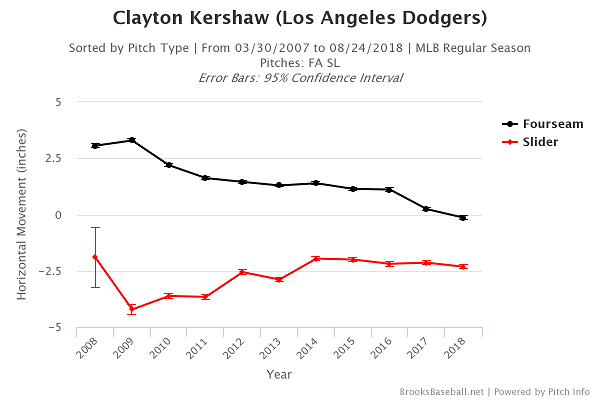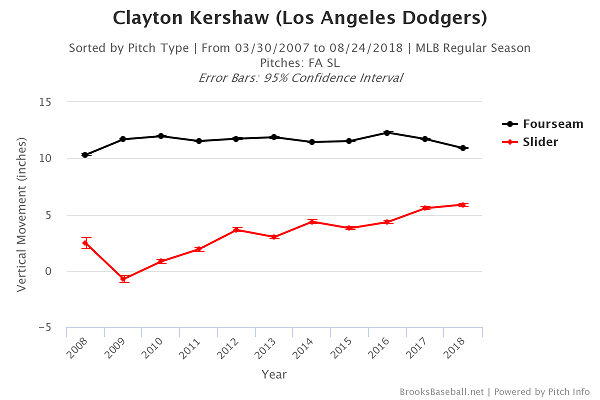
Since the beginning of the season, we’ve been aware of Clayton Kershaw and his diminished fastball velocity. While he’s never been a guy who needed elite-level velo to be elite, the fact his average pitch speed is down anywhere from 1.5 to 2 MPH. It has produced less than great results.
According to FanGraphs pitch value statistic — which is a counting/cumulative stat — since 2008 no pitcher has had a more valuable fastball than Kershaw. It has accumulated 200 value points in that time. Justin Verlander, who debuted three years prior to Kershaw, is second at 141.7. Fun fact, Kenley Jansen is fourth at 136.8.
It’s clear Kershaw’s best pitch, over the course of his entire career, has been his fastball, and that peaked in 2013. But in 2018, it has been a neutral pitch, literally.
| Year | wFB |
| 2013 | 37.8 |
| 2014 | 19.2 |
| 2015 | 24.7 |
| 2016 | 22.0 |
| 2017 | 8.3 |
| 2018 | 0.0 |
Even last season, when his velocity was more in line with his career norms, his fastball still wasn’t the pitch it once was.
Chad wrote about Kershaw’s velocity after his Opening Day start, and the decline was noticeable then.
“While some pitchers take time to ramp up the velocity, Kershaw has never really had that issue, as he normally sits between 93.5 and 94.5 mph on Opening Day. So he was definitely down a tick or two from the norm yesterday, but he was sitting more 91-93 than 90-91, which is still less than ideal but a bit less worrying at least. Remember, 2012 doesn’t really count either, because that was the day he was removed after three innings due to flu-like symptoms. Following that start, he averaged 93.6 mph on his fastball in his next outing. There’s no data for Opening Day in 2014 because that was the year the Dodgers opened in Australia and he subsequently got hurt. But when he did return, his velocity was fine, averaging 94.1 mph in his following start. It’s not worth freaking out about Clayton Kershaw’s velocity yet, but it certainly is worth monitoring if it doesn’t tick back up in subsequent starts, because what he did yesterday was definitely not the norm.”
We’re well beyond freaking out about his velo. We’ve come to accept this as the new reality.
Depending what source you trust most/like, Kershaw is averaging between 90.9 (Baseball Savant/FanGraphs) and 91.5 MPH (Brooks Baseball). That’s … not great. It coupled with the near blending of his fastball and slider, has led to him going from elite to simply really good this season.
As a result, he is throwing his fastball less this season (41.4 percent). That plays into the pitch value being down, but if he were throwing at his pre-2018 velocity, I’m sure that number would be a bit higher. But despite that, his fastball usage has been trending downward, well, nearly his entire career.
| Year | FB% |
| 2008 | 71.5 |
| 2009 | 72.0 |
| 2010 | 71.6 |
| 2011 | 65.3 |
| 2012 | 62.0 |
| 2013 | 60.7 |
| 2014 | 55.4 |
| 2015 | 53.9 |
| 2016 | 50.7 |
| 2017 | 47.1 |
| 2018 | 41.4 |
Among starters with 110 innings pitched, Kershaw’s 41.4 percent mark is 12th-lowest in baseball. Conversely, his 41.0 percent slider usage is 5th-highest in baseball.
Clayton Kershaw’s slider killed his fastball.
When he was coming up through the minors, the biggest knock on him — aside from his command/control, which ultimately improved — was the lack of a true third pitch. He had been toying with a slider and has (seemingly) been toying with a changeup for his entire pro career. In late-May 2009, then-bullpen catcher Mike Borzello (as told by A.J. Ellis to Jonah Keri of, at the time, Grantland) suggested Kershaw should try to throw a slider.
“‘The very first one he throws is just perfect. No one can believe it. Right away, Borzello says, ‘If he throws it like that, that’s a pitch he can throw for a strike, and as a strikeout pitch.’ This was the first time Kersh had ever thrown a slider off a mound in his life.'”
Much like his fastball over the last decade-plus, the slider has been the most valuable pitch in baseball.
| Year | wSL |
| 2008 | N/A |
| 2009 | 3.3 |
| 2010 | 16.2 |
| 2011 | 23.0 |
| 2012 | 3.8 |
| 2013 | 5.3 |
| 2014 | 21.5 |
| 2015 | 15.7 |
| 2016 | 24.4 |
| 2017 | 17.5 |
| 2018 | 15.3 |
The slider is what took him from really good to elite. It made him the pitcher best pitcher in baseball for more than a half-decade. It’s also the reason for his regression. Yes, some of the regression is natural because of age/attrition and injuries, but it’s not like Kershaw is in his mid-to-late 30s. He just turned 30 in March. He has a lot of mileage on his arm since he debuted at age 20, but the fact his slider has gotten closer and closer to his fastball (velocity- and movement-wise) has been the reason for the decreased effectiveness of his 4-seamer.



We may never see the elite version of Kershaw again. That’s fine. It was bound to happen one day. But it’s just so ironic that the pitch that made him a future Hall of Famer is also responsible for his earlier-than-expected decline.
Of course, most pitchers will kill to have a decline that sees him with a 2.40 ERA, 2.86 FIP and a 20.6 K-BB%. It just goes to show how spoiled we have been with Kershaw for the last decade.
 Dodgers Digest Los Angeles Dodgers Baseball Blog
Dodgers Digest Los Angeles Dodgers Baseball Blog